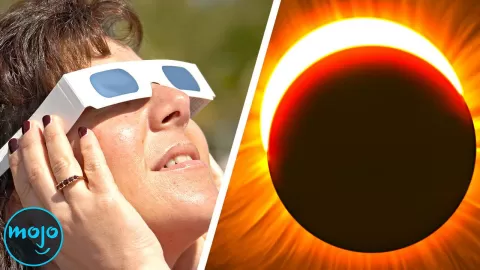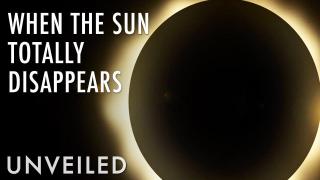Top 10 Weirdest Things to Happen during a Total Solar Eclipse

#10: Psychological Effects on Humans
An eclipse transcends mere astronomical events to touch the depths of human emotion and cognition. Standing in the moon's shadow, individuals often report a profound sense of awe — a momentary feeling of insignificance in the vastness of the universe, juxtaposed with a profound connection to the cosmos. This can evoke deep emotional responses, from exhilarating joy to a serene sense of peace. Researchers have noted that such experiences can have lasting psychological impacts, fostering an increased interest in science and a deeper appreciation for nature. It’s not just a visual marvel but a profound emotional and psychological journey for many.
#9: Increased Plant Activity
Observations during these astronomical events have suggested that plants behave as if night has fallen suddenly. Some flower species that close their petals at dusk may do so, while certain plants have been known to droop or change their leaf orientation in response to the darkness. This activity highlights the sensitivity of plants to light changes, acting on their circadian rhythms in a manner akin to their response to sunset. Such reactions underscore the intricate connection between terrestrial life and celestial events, providing a fascinating glimpse into the adaptability and sensitivity of plant life to the environment's cues, a theme in the natural world we will keep returning to.
#8: Eclipse Wind
5 Weird Things That Happen During a Solar Eclipse | Unveiled
A peculiar and not fully understood aspect associated with solar eclipses is wind. Some have reported experiencing an uncharacteristic drop in wind speed or an abrupt change in direction coinciding with the event’s progression. This is thought to be caused by the rapid cooling of the Earth's surface when the moon obscures the sun, disrupting local weather patterns temporarily. The sudden darkness and temperature drop can lead to atmospheric instability, which might explain the unusual wind behavior. Despite its sporadic documentation, the wind entrances scientists and laypeople alike, adding an atmospheric enigma to the event's awe.
#7: Corona Visibility
During totality, a rare and breathtaking sight becomes visible - the solar corona. This is the sun’s outer atmosphere, usually hidden by the overwhelming brightness of the sun's surface. The corona appears as a wispy, radiant halo surrounding the dark silhouette of the moon, shining in ethereal light. This offers invaluable insights to astronomers, revealing the sun’s magnetic field structure and providing clues about wind and space weather. For gawkers, the sight of the corona is a highlight of the experience, a once-in-a-lifetime opportunity to gaze directly at the sun’s outermost layers in all their splendor.
#6: Diamond Ring Effect
Just as the moon moves to fully cover or uncover the sun during an eclipse, a dazzling delight known as the Diamond Ring Effect occurs. This brilliant spectacle is created when a single beam of sunlight breaks through the lunar valleys, shining brightly against the darkened sky, while the sun's corona forms a halo around the moon, resembling a diamond ring. This fleeting moment marks the beginning or end of totality. The Diamond Ring Effect is not only a visual marvel but also a reminder of the precise celestial mechanics at play, as the massive bodies align perfectly in the sky.
#5: Bailey's Beads
Bailey's Beads emerge in the fleeting moments before and after the totality. As the moon passes in front of the sun, sunlight filters through the landscape's rugged terrain - valleys, mountains, and craters. This results in the appearance of bright spots around the edge, resembling a string of luminous beads. Named after Francis Bailey, who first provided an explanation for it, Bailey's Beads offer a rare glimpse into the irregularities of the lunar surface. Witnessing this transient display provides a scintillating and dynamic interplay between light and shadow in the outer space ballet.
#4: Temperature Drop
One of the most palpable effects of these rare events is the sudden drop in temperature. As the moon obscures the sun, its shadow casts a temporary chill over the Earth below, leading to a decrease in temperature that can be as significant as 10 degrees Fahrenheit (or 5 and a half degrees Celsius). This highlights the sun's critical role in maintaining Earth's surface temperature and demonstrates how quickly our environment can change with slight variations in exposure. For many, the sudden coolness adds an eerie, yet exhilarating, dimension to the whole environment, enhancing the surreal nature of the moment.
#3: Animal Behavior Changes
Top 5 Things You Should Know Animal Testing
A solar eclipse brings about a dramatic shift in the behavior of animals and insects, as they are tricked into thinking night has suddenly fallen. Diurnal animals may begin their evening routines, birds may stop singing, and some nocturnal creatures stir into activity. For example, cicadas, which are known for their loud, buzzing songs during hot summer days, may start their evening chorus as the sky darkens, only to fall silent again as the sunlight returns. This unusual changing of routines offers a fascinating insight into the natural world, showcasing the reliance of wildlife on light cues to regulate their behavior.
#2: 360-Degree Sunset or Sunrise
Top 10 Weirdest Things To Happen In The Olympic Village
A 360-degree sunset, or sunrise depending on your perspective, is a — literal — otherworldly experience. As the moon looms over a specific area of the Earth, observers positioned within the path of totality are treated to a panoramic twilight at midday. The horizon glows in soft hues typically seen at dawn or dusk, enveloping the sky in a surreal light. This breathtaking visual effect underscores the unique atmospheric conditions created by the event, blending day with night in a spectacle of color and light rarely witnessed in a lifetime. There’s a reason eclipses have loomed large throughout recorded history.
#1: Shadow Bands
The Untold Story of the Anthrax Attacks In The Shadow of 9/11
These are among the most elusive and intriguing phenomena associated with solar eclipses. These are faint, wavy lines of alternating light and dark that can be seen moving rapidly across the ground in brief moments. The cause of shadow bands is thought to be the Earth's atmosphere refracting the last few rays of sunlight as the sun is blocked. This atmospheric lensing effect creates a rippling pattern reminiscent of light reflecting off the bottom of a swimming pool. The bands captivate with their fleeting beauty, adding yet another layer of mystery as they dance across the surfaces. Have you ever witnessed an eclipse? Tell us your experience in the comments down below!





